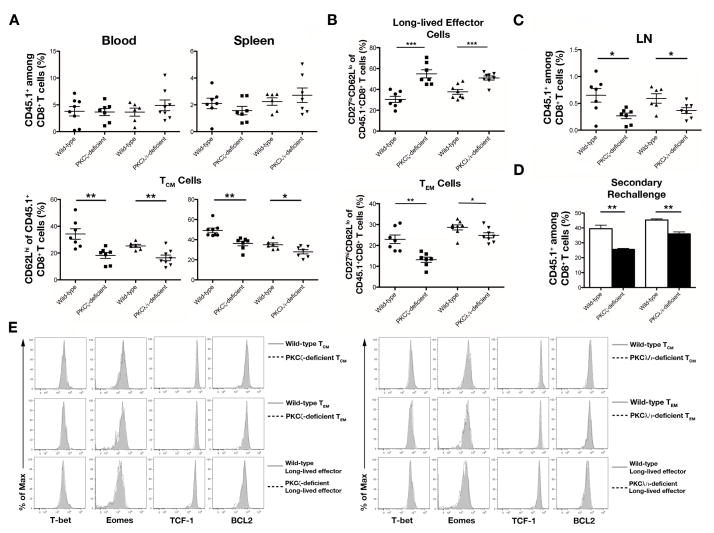Figure 5.
PKCζ and PKCλ/ι regulate central and effector memory CD8+ T cell differentiation. (A) Frequencies of CD45.1+CD8+ T cells (top) and CD62LhiCD45.1+CD8+ TCM cells (bottom) in the blood and spleen on day 50 post-infection; each point represents an individual mouse and lines indicate the mean ± SEM; n = 6–7/group. (B) Frequencies of CD27loCD62LloCD45.1+CD8+ long-lived effector T cells (top) and CD27hiCD62LloCD45.1+CD8+ TEM cells (bottom) in the spleen on day 50 post-infection; each point represents an individual mouse and lines indicate the mean ± SEM; n = 7–8/group. (C) Frequencies of CD45.1+CD8+ T cells in the lymph nodes on day 50 post-infection; each point represents an individual mouse and lines indicate the mean ± SEM; n = 6–7/group. (D) Frequencies of CD45.1+CD8+ T cells on day 8 in the blood of mice that received 104 wild-type, PKCζ-deficient, or PKCλ/ι-deficient CD45.1+CD8+ T cells on day 50 post-infection and were subsequently challenged with 105 CFU Lm-OVA. Bars indicate the mean ± SEM; n = 4/group. (E) Expression of T-bet, Eomes, TCF-1, and BCL2: left, wild-type (gray filled) and PKCζ-deficient (dashed black) CD45.1+CD8+ TCM cells (top), TEM cells (middle), and long-lived effector T cells (bottom); right, wild-type (gray filled) and PKCλ/ι-deficient (dashed black) CD45.1+CD8+ TCM cells (top), TEM cells (middle), and long-lived effector T cells (bottom) in the spleen on day 50 post-infection. For (A–D) *P < 0.05, **P < 0.01, and ***P < 0.001 (two-tailed unpaired t-test). Data are representative of two (D) or three (A–C, E) experiments.

